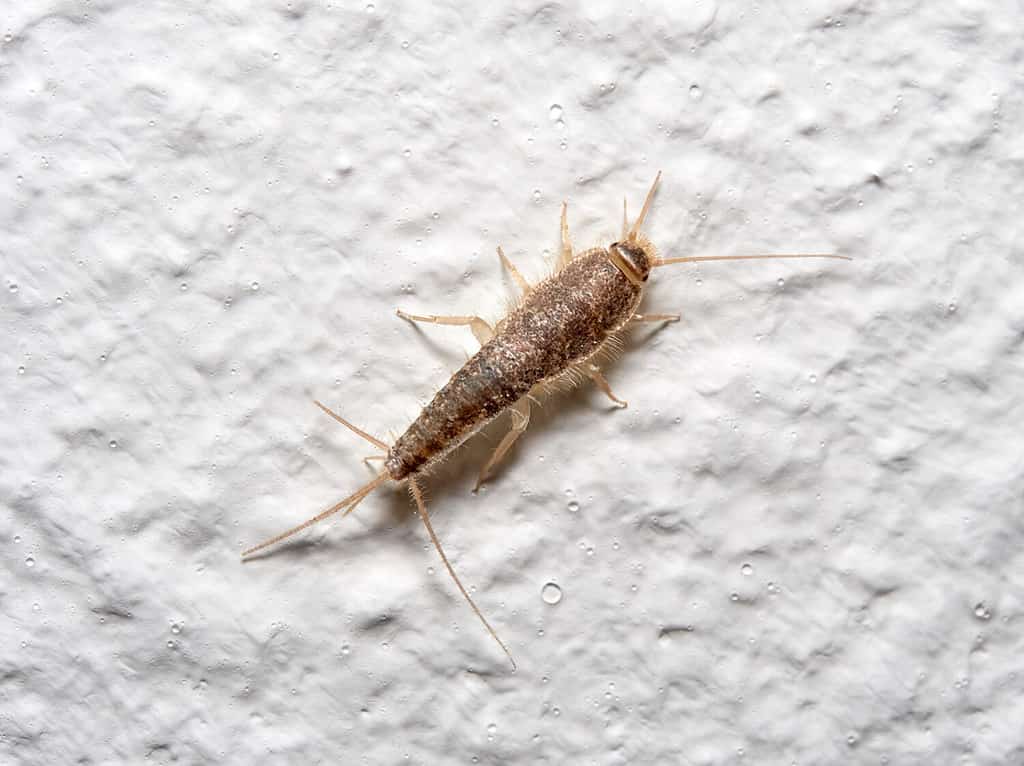Found throughout the United States, silverfish are wingless insects that inhabit high-moisture areas such as gardens, leaf piles, or caves. When outdoors, silverfish help decompose plant matter and are essential in the food chain for spiders and centipedes. Indoors, however, they can be a pest. Feeding on starchy items, these little insects damage books and clothes, not to mention any stored food. Here are six ways to get rid of silverfish and ensure they stay outside your home.
#1 Get Rid of Moisture

In their natural environment, silverfish inhabit moist plant litter or gardens. But, indoors, silverfish are drawn to basements and bathrooms.
©2Dvisualize/Shutterstock.com
A silverfish’s ideal environment is moist and humid. So, you are most likely to find them in your basement or bathroom. Making sure that these areas of your home are well-ventilated will be helpful. Also, running a dehumidifier will extract moisture from the air, creating a drier area. Solving underlying causes of humidity, such as leaky pipes or filling in cracks along your foundation, keeps water out of your home. Having a dry house is one way to get rid of silverfish.
#2 Seal Up Food Sources

Silverfish love starchy foods such as flour, cereal, and pasta.
©Olga Peshkova/iStock via Getty Images
Sugars and other starchy items are a buffet for silverfish. Not only will they infest pet food, but they will also target cereal, flour, sugar, and more. No one wants to pour a bowl of cinnamon toast silverfish! So, ensure all your dry staples are in plastic, airtight containers because silverfish also eat through cardboard.
Magazines, books, and boxes of paper draw silverfish as well. Keeping these items sealed in plastic totes or bins will cut silverfish off from their food source. And, if you are moving these items to a new location, check to ensure these insects aren’t hitching a ride inside.
Cutting off a silverfish’s food source is another way to get rid of silverfish from your home.
#3 Natural Repellents

Cedar oil or cedar shavings are a natural way to get rid of silverfish.
©Madeleine_Steinbach/iStock via Getty Images
While most evidence for these natural repellents is anecdotal, many claim to have had success. A few options include:
- Cloves
- Cinnamon
- Cedar chips or shavings
- Cedar oil spray
Also, vacuuming up existing silverfish is a simple way to dispose of the ones you see. In addition, sticky tape may take care of small infestations.
#4 Apply Diatomaceous Earth

Diatomaceous earth is an excellent option for those who own pets, as it is safe for animals.
©marekuliasz/Shutterstock.com
This white powder is composed of the fossilized remains of aquatic organisms. These organisms, called diatoms, have skeletons, which are made up of silica. When silica reacts to oxygen and water, it produces silicon dioxide. Most diatomaceous earth contains silicon dioxide, and it was registered as one of the first pesticides to terminate insects and mites in 1960.
What is nice about diatomaceous earth is that it is not toxic, unlike boric acid. So, it is a good option for pet-friendly homes. The tiny, sharp edges of diatomaceous earth cut up the exoskeleton of the silverfish, and then it absorbs the oils and fat from the insect. Essentially, diatomaceous earth causes a silverfish to dry out and die.
Since silverfish are nocturnal, applying diatomaceous earth in the evening is best. If there is activity, be sure to reapply the diatomaceous earth for several nights in a row.
#5 Chemical Sprays

Boric acid is effective for silverfish. However, it is toxic to humans and pets if swallowed.
©Macronatura.es/Shutterstock.com
Boric acid is an option for small infestations. However, the downside of boric acid is that it is harmful to humans and pets if it is ingested. So, homes with pets and small children should avoid using boric acid.
Insecticides are most effective for large infestations. Sprays with synergized pyrethrin and pyrethroids have the most evidence of working. Look for sprays containing bifenthrin, cyfluthrin, tetramethrin, and phenothrin. These will eliminate silverfish on contact. But follow the label instructions. Some sprays are flammable, so do not apply them around fire sources.
#6 Pest Control Professionals

Sometimes, the best way to get rid of silverfish in your home is to hire a pest control professional.
©PPC Photography Cologne/Shutterstock.com
If your silverfish infestation is out of control, it is time to contact a professional to dispose of them. Calling a local, licensed pest control professional will help you eliminate the silverfish for good. Because of a pest controller’s expertise and access to appropriate treatments, you can rest assured that the problem will be solved. While it may be expensive, this is the most effective way to get rid of silverfish in your home.
Summary of the 6 Ways to Get Rid of Silverfish
| Number | Method |
|---|---|
| #1 | Get Rid of Moisture |
| #2 | Seal Up Food Sources |
| #3 | Natural Repellent |
| #4 | Apply Diatomaceous Earth |
| #5 | Chemical Sprays |
| #6 | Pest Control Professionals |
The photo featured at the top of this post is © Tomasz Klejdysz/Shutterstock.com
Thank you for reading! Have some feedback for us? Contact the AZ Animals editorial team.






